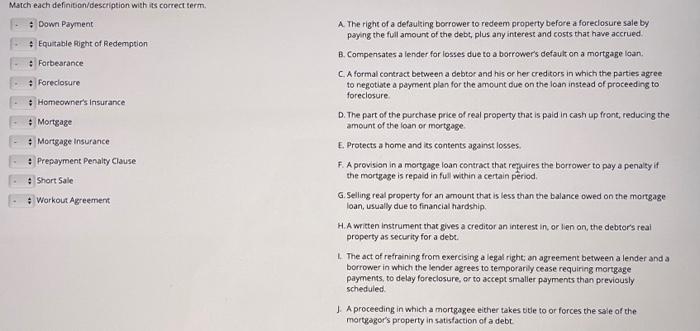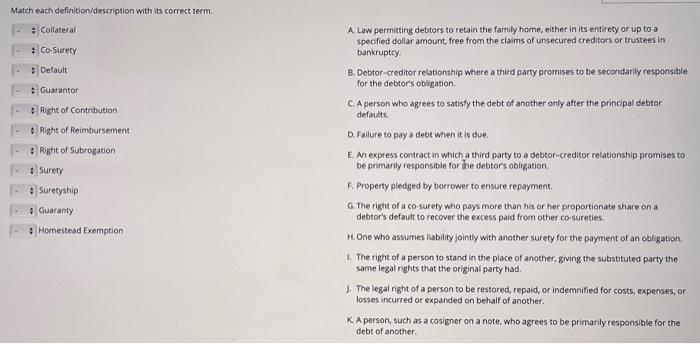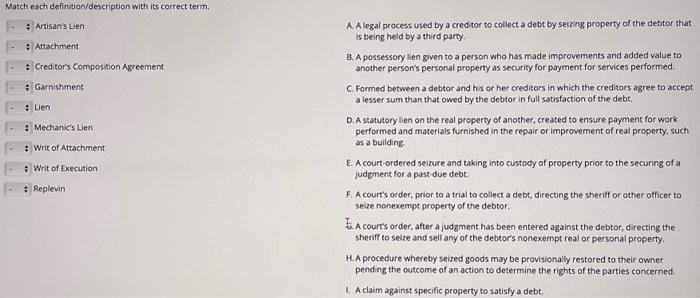Law questions

Down Payment A. The right of a defaulzing borrower to redeem property before a foreclosure sale by paying the fuil amount of the debt, plus any interest and costs that have accrued Equitable Right of Redemption B. Compensates a lender for losses due to a borrower's defaut on a mortgage loan. Forbearance C. A formal contract between a debtor and his or her creditors in which the parties agree Foreciovure to negotiate a payment plan for the amount due on the loan instead of proceeding to foreclosure. Homeowner's insurance D. The part of the purchase price of real property that is paid in cash up front, reducing the Mortgage amount of the loan or mortgage. Mortgage insurance E. Protects a home and is contents against losses. Prepayment Penalty Clause F. A provision in a mortgage loan contract that rejpuires the borrower to pay a penatyy if Short Sale the mortgage is repaid in full within a certain period. Workout Agreement G. Selling real property for an amount that is less than the balance owed on the mortgage loan, usually due to financial hardship. H.A wricten instrument that gives a creditor an interest in, or lien on, the debtors reai property as security for a debe. 1. The act of refraining from exercising a legal right; an agreement between a lender and a borrower in which the lender agrees to temporarily cease requiring mortgage payments, to delay foreclosure, or to accept smaller payments than previously scheduled. 1. A proceeding in which a mortgagee eicher takes titje to or forces the sale of the mortgagor's property in satisfaction of a debt. Match each definitionvidescription with its correct term. Collateral A. Law permitting debtors to retain the family home, either in its entirety or up to a specified dollar amount, free from the claims of unsecured creditors or trustees in Co-Surety bankruptcy. Default 8. Debtor-creditor relationship where a third party promises to be secondarily responsible for the debtor's obligation. Guarantor C. A person who agrees to satisfy the debt of another only after the principal debtor Right of Contribution defaults. Right of Reimbursement D. Failure to pay a debt when it is due. Right of Subrogation E. An express contract in which a third party to a debtor-creditor relationship promises to Surety be primarily responsible for the debtor's obligation. Suretyship F. Property pledged by barrower to ensure repayment. Guaranty 6. The right of a co surety who pays more than his or her proportionate share on a debtor's default to recover the excess paid from other co-sureties. Homestead Exemption H. One who assumes liability jointy with another surety for the payment of an obligation. 1. The right of a person to stand in the place of another, giving the substituted party the same legal rights that the original party had. 2. The legal right of a person to be restored, repaid, or indemnified for costs, expenses, or losses incurred or expanded on behalf of another. K. A person, such as a cosigner on a note, who agrees to be primarily responsible for the debt of another. Artisan's Lien A. A legal process used by a creditor to collect a debt by seizing property of the debtor that is being held by a third party Attachment B. A possessory lien given to a person who has made improvements and added value to Creditor's Composition Agreement another person's personal property as security for payment for services performed Garnishment C. Formed between a debtor and his or her creditors in which the creditors agree to accept a lesser sum than that owed by the debtor in full satisfaction of the debt. Lien D. A statutory lien on the real property of another, created to ensure payment for work Mechanic's Lien performed and materials furnished in the repair or improvernent of real property, such Writ of Attachment as a buliding. Writ of Execution E. A court-ordered seizure and taking into custody of property prior to the securing of a judgment for a past-due deat. Replevin F. A court's order, prior to a trial to collect a debt, directing the sheriff or other officer to seize nonexempt property of the debtor. I. A court's order, after a judgment has been entered against the debtor, directing the sheriff to seize and sell any of the debtor's nonexempt real or personal property. H.A procedure whereby seired goods may be provisionally restored to their owner pending the outcome of an action to determine the rights of the parties concerned. 1. A claim against specific property to satisfy a debt










